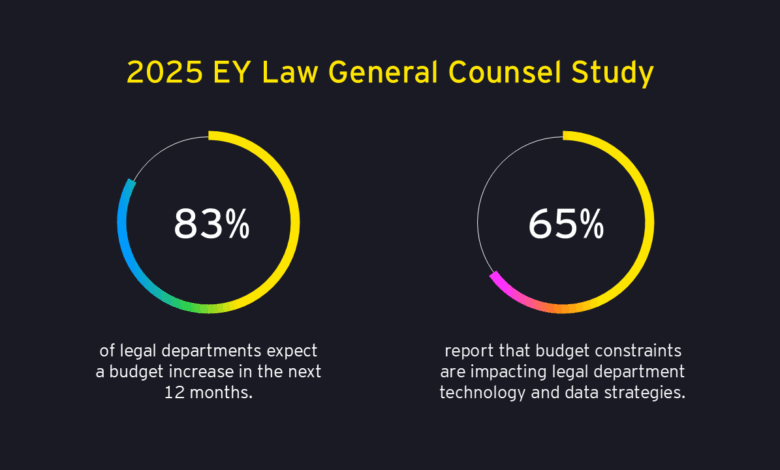
Technology is a crucial enabler that can help to generate the efficiency, collaboration and insights needed by legal departments today. Indeed, in a recent study by EY Law of 1,000 General Counsel and Chief Legal Officers across 21 countries (EY Law study), 91% of legal departments reported that digitization of the legal department is a priority, with half reporting that it is a high priority.
The technology options available to legal departments have multiplied tremendously in recent years, due in part to the evolution of generative AI (GenAI). However, while 83% of legal departments anticipate a budget increase over the next 12 months, 65% report that budget constraints are impacting legal department technology and data strategies. Traditionally considered a cost center, it’s unlikely that most legal departments will ever be given a blank check for technology, but they can take steps to help ensure that their budget and resources are used for maximum impact.
Legal department expectations for technology
Expectations are high as technology has the potential to offer efficiencies and insights that will help legal departments better manage complex and growing work volumes and add value to the business. According to the EY Law study, better technology, including GenAI and agentic AI, was cited as the key to advancement in several areas, including regulatory compliance, managing risk, engaging talent and reducing costs as outlined in more detail below:
Engage talent – According to the EY Law study, talent retention is a high priority for many legal departments as 64% plan to develop more access to knowledge by upskilling or reskilling current in-house talent. To engage and retain talent, 71% are creating better knowledge and data management and 62% are investing in technology and tools.
Manage risk – With daily changes in geopolitics, the regulatory environment, technology advancements and business expectations, 81% of legal departments expect their organization to increase investment in risk management over the next 12 months. Fifty-two percent expect more investment in technology implementations and upgrades to enhance risk management capabilities including contract and document management (68%), communication and collaboration (61%) and data analysis (52%). Indeed, 62% of legal departments plan to use GenAI for contract review and risk analysis over the next year (in addition to the 19% that already use GenAI).
Improve regulatory compliance – Regulatory compliance is an especially high priority for 75% of legal departments, and 50% plan to secure better technology to help address critical challenges in tracking for regulatory change and accessing data needed for risk management or reporting. GenAI is also a focus for legal departments in this area as 49% are planning to use GenAI for regulatory compliance over the coming year (in addition to the 20% that already use GenAI).
Reduce costs – Ironically, 63% of legal departments are also planning to increase the use of technology and automation over the next 12 months to help control costs through increased efficiency.
Steps to improve the benefits of technology
There are several steps legal departments can take to focus their technology initiatives, redirect budget responsibility and successfully improve the potential benefits of technology despite current budget pressures.
- Understand where technology can help most. Technology often fails to gain traction because it adds complexity without providing support where it matters most. As a result, it can become difficult to cultivate support from the business for future technology initiatives. To help prioritize initiatives and increase the likelihood of success, it is imperative to work closely with business stakeholders to align around business priorities, problems that need to be solved and root causes so that the legal department can understand where technology can have the greatest impact. Use these insights to generate a clear, prioritized list of objectives and technology capabilities that the legal department needs to achieve those objectives.
- Identify the ultimate technology owner. In some instances, the legal department requires technology to support processes that are primarily owned by legal, such as IP asset management, legal knowledge management and eDiscovery. In these examples, legal is the primary user of the technology, so it follows that the legal department bears responsibility for securing the necessary budget.
In other instances, the legal department is supporting specific steps in a larger process that is owned by other functions. Procurement and commercial contracting, third-party risk management and compliance are examples where this may be the case. In such instances, the function(s) ultimately responsible for the end-to-end process is also responsible for the supporting technology and the budget required to procure and maintain it.
- Focus on the “must haves”. Whether the technology used by the legal department is owned by legal or another function, it is critical to focus on the platforms and capabilities that offer the functionality needed most by the legal department to achieve its objectives. Avoid the latest, shiny tools that offer a multitude of unnecessary capabilities. Be sure to consider the support levels that are offered, usability, whether the solution can flex and scale to address evolving needs and whether it offers necessary integration with other legal or enterprise applications. Also, apply learnings around what has and has not gone well from previous technology acquisitions to help increase the likelihood of success.
- Consider alternative sources. In many instances, it may make sense for an organization to procure technology directly from a technology vendor, however, there may also be benefits for organizations to access technology through an external service provider. According to the EY Law study, 35% of legal departments report that accessing technology through an external service provider is a high priority as it can help to increase implementation success and bring down long-term maintenance costs.
- Establish spend management rigor. Some legal departments may have the ability to make operating adjustments that will allow them to dedicate a higher percentage of their budgets to technology, however, only 24% of legal departments have conducted a spend management assessment over the past year. Data analysis around actual expenses, spend patterns and industry standards is critical information that legal departments can use to understand where they can better manage costs and invest in technology that will deliver valuable return on investment (ROI).
- Set goals and metrics to justify future investment. Establish goals and metrics that are aligned with the legal department’s technology objectives so that you can measure ROI success and gather data that can be used to justify future business cases for technology investment.
Conclusion
As seen in the EY Law study, technology today plays an important role in enabling legal departments and improving legal service delivery. As many legal functions historically did not have high technological demands, they will need to make the case for change and articulate the importance of technology to obtain access to further funding that will allow them to make the most of GenAI which is changing how legal professionals work.
While many legal departments today are currently testing GenAI and not yet applying it to legal service delivery, this is a crucial and important phase for legal professionals as they learn and adapt their ways of working so that GenAI is part of daily routines. With the increased application of GenAI, a professional “renaissance” – a period of renewed growth, revival or reinvention – will undoubtedly follow within the legal profession. The views reflected in this article are the views of the author and do not necessarily reflect the views of the global EY organization or its member firms.




